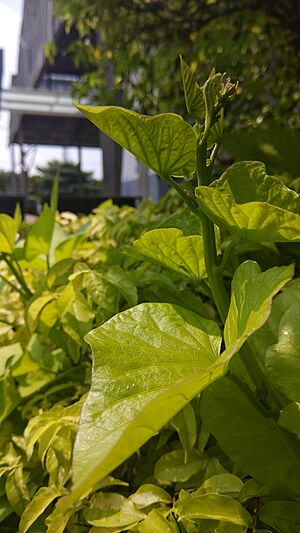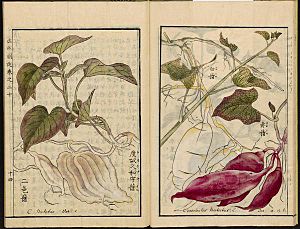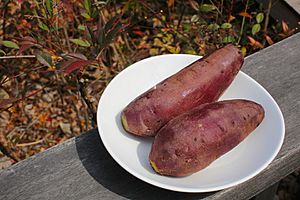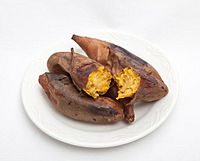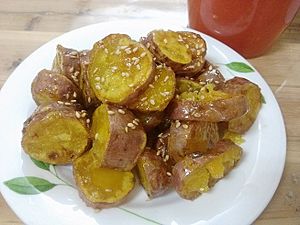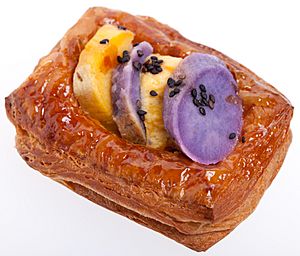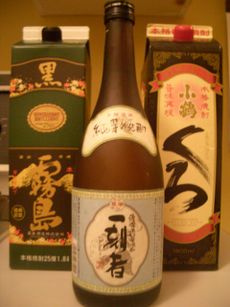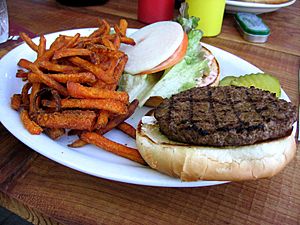Sweet potato facts for kids
Quick facts for kids Sweet Potato |
|
|---|---|
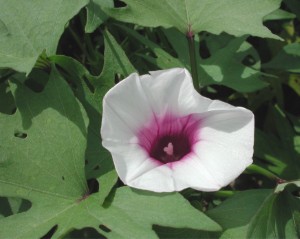 |
|
| Sweet potato in flower Hemingway, South Carolina |
|
| Scientific classification | |
| Kingdom: | |
| (unranked): | |
| (unranked): | |
| (unranked): | |
| Order: | |
| Family: | |
| Genus: | |
| Species: |
I. batatas
|
| Binomial name | |
| Ipomoea batatas (L.) Lam.
|
|
The sweet potato (Ipomoea batatas) is a plant that belongs to the morning glory family. It is grown for its sweet, edible roots, which are also called sweet potatoes. These roots are packed with fiber and beta-carotene, which is good for your health. People all over the world enjoy eating sweet potatoes.
Contents
What's in a Name?
Even though some people in North America call soft, orange sweet potatoes "yams," sweet potatoes are actually very different from true yams. True yams (Dioscorea) are a different type of plant. They grow in many parts of the world and belong to a plant family called Dioscoreaceae. Another plant, the oca (Oxalis tuberosa), is also sometimes called a "yam" in places like New Zealand.
Sweet potatoes are not closely related to the common potato, but they share a similar name history. The first Europeans to try sweet potatoes were with Christopher Columbus in 1492. They found many different kinds of sweet potatoes with various local names. The name that stuck was batata, which came from the Taíno people. Later, the Spanish combined this with the Quechua word for potato, papa, to create patata for the common potato.
Some experts suggest writing "sweetpotato" as one word. This helps show that it's a unique plant, different from both common potatoes and yams. However, in American English, "sweet potato" (two words) is still more common.
In countries like Argentina, Venezuela, and Brazil, the sweet potato is called batata. In Mexico, Peru, and the Philippines, it's known as camote. This name comes from the Nahuatl word camotli. In Peru, the Quechua word for a type of sweet potato is kumar. This is very similar to the Polynesian name kumara. This similarity has made some scholars wonder if people traveled across the ocean between South America and Polynesia a long time ago.
In Australia, most sweet potatoes grown are an orange type called "Beauregard." This type was first developed in Louisiana in 1981. In New Zealand, the original Māori varieties had white skin and whitish flesh. These were called kumara. Today, the most common type is a red one called Owairaka. Orange, gold, and purple varieties are also popular. Kumara is often roasted and served with sour cream and sweet chili sauce.
Where Do Sweet Potatoes Come From?
Sweet potatoes first grew and were farmed in either Central America or South America. In Central America, people were growing sweet potatoes at least 5,000 years ago. The plant likely started growing somewhere between Mexico's Yucatán Peninsula and the Orinoco River in Venezuela. From there, local people probably spread the plant to the Caribbean and South America by 2500 BCE.
Sweet potatoes were also grown in Polynesia before Europeans explored the area. These plants usually spread from vine cuttings, not seeds. Scientists have used Radiocarbon dating to show that sweet potatoes were in the Cook Islands by 1400 CE. One idea is that Polynesian travelers brought sweet potato vine cuttings from South America back to central Polynesia. From there, the plant spread across Polynesia to places like Easter Island, Hawaii, and New Zealand.
How Sweet Potatoes Spread Around the World
Sweet potatoes first arrived in the Philippines during the Spanish colonial period (1521-1598). They came on ships called Manila galleons, along with other new crops from the Americas. Around 1594, sweet potatoes were brought to the Fujian province in China from Luzon. This happened after a big crop failure, and growing sweet potatoes helped prevent famine.
The Portuguese introduced sweet potatoes to the Ryukyu Kingdom (now Okinawa, Japan) in the early 1600s. Sweet potatoes became a very important food in Japan because they helped people survive when rice harvests were bad. They were even planted in the private garden of Shōgun Tokugawa Yoshimune. Sweet potatoes also came to Korea in 1764.
Sweet potatoes reached Europe through the Columbian exchange, which was a big exchange of plants, animals, and ideas between the Americas and Europe. For example, a cookbook from England in 1604, called Elinor Fettiplace's Receipt Book, mentions sweet potatoes.
Sweet Potato Production Around the World
In 2017, the world produced 113 million tonnes of sweet potatoes. China grew the most, making up 64% of the total. Other big producers were Malawi and Nigeria.
Cooking with Sweet Potatoes
While the leaves and shoots of the sweet potato plant can also be eaten, the starchy roots are the most important part. In some warm, tropical areas, sweet potatoes are a main food source for people.
Sweet Potatoes in Africa
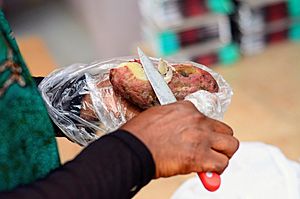
In northeastern Uganda, people eat Amukeke (sun-dried sweet potato slices) and inginyo (sun-dried crushed sweet potato). Amukeke is often eaten for breakfast with peanut sauce. Inginyo is mixed with cassava flour and tamarind to make atapa, which is eaten with smoked fish or dried cowpea leaves in peanut sauce. Emukaru (earth-baked sweet potato) is a snack, often served with tea or peanut sauce. Similar dishes are found in South Sudan.
The young leaves and vine tips of sweet potatoes are eaten as a vegetable in West African countries like Guinea, Sierra Leone, and Liberia. They are also popular in northeastern Uganda. These leaves are a good source of vitamins A, C, and B2, and are excellent for lutein.
In Kenya, a guide has been written on how to use sweet potatoes in modern recipes. This includes using mashed sweet potatoes or flour made from dried sweet potatoes. This flour can replace some wheat flour and sugar in baked goods like cakes, chapatis, and cookies. A healthy juice can be made from orange sweet potatoes, and deep-fried snacks are also popular.
In Egypt, sweet potatoes are called "batata" (بطاطا). They are a common street food in winter. Street vendors sell them from carts with ovens, especially near the Nile River. Both orange and white sweet potatoes are used. People also bake them at home as a snack or dessert, often with honey.
In Ethiopia, common sweet potatoes are black-skinned with cream-colored flesh, called "bitatis" or "mitatis." They are grown in the eastern and southern low highlands and harvested in the rainy season. Recently, new orange sweet potato types have been introduced. These have less sugar and more vitamin A. Sweet potatoes are widely eaten boiled as a favorite snack.
Sweet Potatoes in Asia
In East Asia, roasted sweet potatoes are a popular street food. In China, yellow sweet potatoes are often baked in large iron drums and sold in winter. In Korea, sweet potatoes, called goguma, are roasted in drum cans or baked over an open fire, especially in winter.
In Japan, a similar roasted sweet potato dish is called yaki-imo. It often uses yellow or purple sweet potatoes. Sweet potato soup, served in winter, is made by boiling sweet potato with rock sugar and ginger. Sweet potato greens are a common side dish in Taiwan. They are often boiled or stir-fried with garlic and soy sauce.
In some parts of India, sweet potato is roasted over kitchen coals and eaten with toppings. In southern India, it's often boiled or pressure cooked, then peeled, cubed, and seasoned as a vegetable dish. In Tamil Nadu, it's called 'Sakkara valli Kilangu' and eaten as an evening snack. Some Indian communities dry and grind sweet potatoes into flour, mixing it with wheat flour to make chapattis (bread). Sweet potatoes are also used to make pickles and snack chips, and some are fed to cattle.
In Pakistan, sweet potato is called shakarqandi. It's cooked as a vegetable or with meat dishes like chicken or mutton. Roasted sweet potatoes are sold as a snack and street food in Pakistani markets, especially in winter.
In Sri Lanka, it's called 'Bathala'. The roots are mainly eaten for breakfast (boiled with sambal or grated coconut) or as a side dish with rice.
In the Maldives, sweet potato roots, called kattala, are part of the traditional diet. The leaves are finely chopped and used in dishes like mas huni.
In Japan, sweet potatoes (satsuma-imo) and purple yams (beni-imo) are grown. Boiling, roasting, and steaming are common cooking methods. They are also used in vegetable tempura. Daigaku-imo is a baked sweet potato dessert. Because they are sweet and starchy, sweet potatoes are used in traditional Japanese sweets like imo-kinton. Shōchū, a Japanese spirit, can be made from sweet potato and is called imo-jōchū. Imo-gohan, sweet potato cooked with rice, is popular in Japan. It's also served in nimono, boiled and flavored with soy sauce and mirin.
In Korean cuisine, sweet potato starch is used to make dangmyeon (cellophane noodles). Sweet potatoes are boiled, steamed, or roasted. Young stems are eaten as namul. Pizza places in Korea sometimes use sweet potatoes as a topping. Sweet potatoes are also used to make a type of Soju. A popular Korean snack, goguma-mattang, is made by deep-frying sweet potato chunks and coating them in caramelized sugar.
In Malaysia and Singapore, sweet potato is often cut into cubes and cooked with taro and coconut milk to make a sweet dessert called bubur caca. Fried sweet potato slices in batter are a popular tea-time snack. At home, sweet potatoes are usually boiled. The leaves are often stir-fried with garlic or with sambal belacan and dried shrimp.
In the Philippines, sweet potatoes (camote or kamote) are an important food crop, especially in rural areas. They are often a main food for families because they are easy to grow and cheaper than rice. The roots are boiled or baked in coals and can be dipped in sugar or syrup. Young leaves and shoots (talbos ng kamote) are eaten fresh in salads with shrimp paste or fish sauce. They can also be cooked in vinegar and soy sauce with fried fish. The purple liquid from boiling camote tops is often mixed with lemon for a drink. Fried sweet potatoes coated with caramelized sugar on skewers (camote cue) are popular afternoon snacks. Sweet potatoes are also used in a dessert called ginatan, cooked in coconut milk with other roots, sago, and jackfruit. Bread made from sweet potato flour is also becoming popular. Sweet potatoes are easy to grow and are often found near canals and dikes. Uncultivated plants are sometimes fed to pigs.
In Indonesia, sweet potatoes are called ubi jalar. They are often fried in batter and served as snacks with spicy sauces. In the mountainous parts of West Papua, sweet potatoes are a main food. People there use a cooking method called bakar batu (burning rocks). Hot rocks are put into a pit lined with leaves, then layers of sweet potatoes, vegetables, and pork are piled on top. More leaves cover the pile, creating steam that cooks the food for several hours.
Young sweet potato leaves are also used as baby food, especially in Southeast Asia and East Asia. Mashed sweet potato roots are used as baby food around the world.
Sweet Potatoes in the United States
Candied sweet potatoes are a side dish made from sweet potatoes cooked with brown sugar, marshmallows, maple syrup, or other sweet ingredients. This dish is often served in America on Thanksgiving. Sweet potato casserole is another side dish, made with mashed sweet potatoes and topped with a brown sugar and pecan mixture.
Sweet potatoes became a favorite food for French and Spanish settlers in Louisiana and have been grown there for a long time. The sweet potato is the state vegetable of North Carolina. Sweet potato pie is also a traditional favorite dish in the Southern U.S. cuisine. Another type of pie is the Okinawan (Sweet Potato) Haupia pie, made with purple sweet potatoes from Hawaii.
The tradition of fried sweet potatoes in the United States goes back to the early 1800s. Sweet potato fries or chips are common. They are made by cutting sweet potatoes into thin strips and deep-frying them, similar to French fries. Roasting sliced or chopped sweet potatoes with oil at high heat became popular in the U.S. in the early 2000s. Mashed sweet potato is served as a side dish, often at Thanksgiving dinner or with barbecue.
John Buttencourt Avila is known as the "father of the sweet potato industry" in North America.
Sweet Potatoes in New Zealand
The Māori people of New Zealand traditionally grew several small, yellow-skinned varieties of sweet potato, which they called kumara. These were brought from East Polynesia. In the early 1800s, larger varieties were introduced by American traders and quickly became more popular.
Māori traditionally cooked kūmara in an hāngi, which is an earth oven. This method is still used today for large gatherings.
In 1947, a disease called black rot affected kumara crops. A disease-free type was developed by Joe and Fay Gock, who later gave it to the nation.
Today, there are three main types of kumara sold in New Zealand: 'Owairaka Red' (red), 'Toka Toka Gold' (gold), and 'Beauregard' (orange). New Zealand grows about 24,000 tonnes of kumara each year, with most of it (97%) grown in the Northland region. Kumara are available all year and are a popular alternative to potatoes. They are a key part of roast meals in New Zealand, served alongside potatoes and pumpkin.
Other Uses of Sweet Potatoes
Among the Urapmin people of Papua New Guinea, taro and sweet potato are the main foods. In fact, their word for "food" combines the words for these two plants.
In Spain, sweet potato is called boniato. On the evening of All Souls' Day in Catalonia, it's traditional to eat roasted sweet potato and chestnuts. Sweet potato is also used to make cakes or eaten roasted throughout the country.
In Peru, sweet potatoes are called 'camote' and are often served with ceviche, a seafood dish. Sweet potato chips are also a common snack.
Dulce de batata is a traditional dessert in Argentina, Paraguay, and Uruguay. It's a sweet jelly made from sweet potatoes. It looks like marmalade but has a firmer texture and is sliced like a pie. It's often served with a piece of soft cheese on top.
In the Veneto region of Italy, sweet potato is known as patata mericana (American potato). It's grown in the southern part of the region and is a traditional fall dish, eaten boiled or roasted.
Globally, sweet potatoes are now a common ingredient in modern sushi, especially in maki rolls. Chef Bun Lai is credited with introducing sweet potato rolls in the 1990s as a plant-based option for sushi.
Non-Food Uses
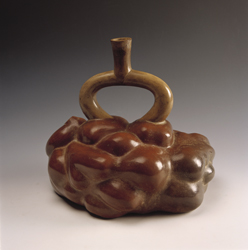
Ancient Moche culture in South America often made ceramics shaped like sweet potatoes.
In South America, the juice from red sweet potatoes is mixed with lime juice to make a dye for cloth. By changing how much of each juice is used, colors from pink to black can be made. Purple sweet potato color is also used as a natural food coloring.
Sweet potato vine cuttings can grow roots quickly in water. They can live in water indefinitely with good light and nutrients. Because of this, sweet potato vines are great for home aquariums. Their roots grow in the water and absorb harmful ammonia and nitrates, which are waste products from fish. This helps keep the water clean and provides hiding places for fish.
See also
 In Spanish: Batata para niños
In Spanish: Batata para niños


